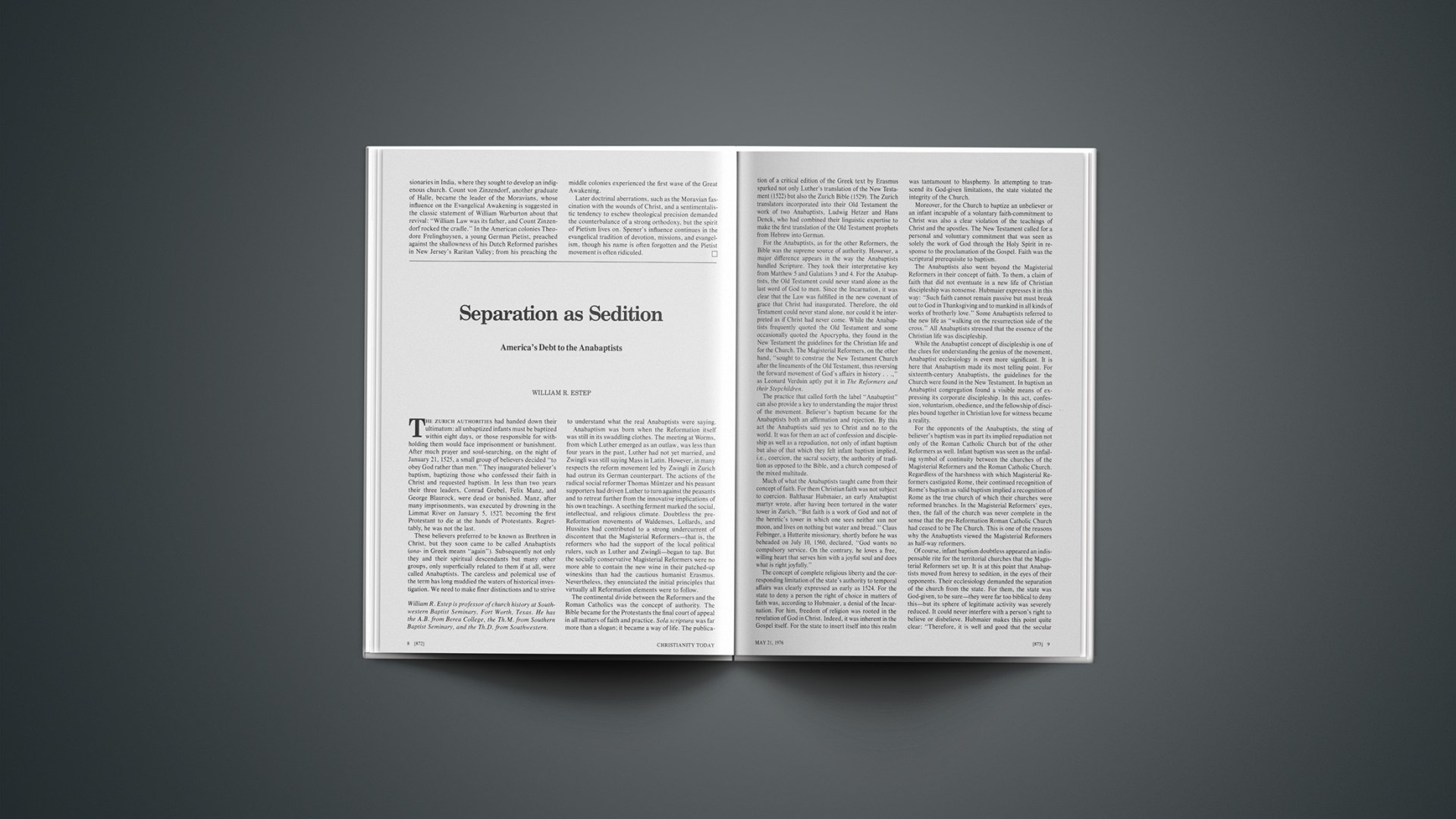The Zurich authorities had handed down their ultimatum: all unbaptized infants must be baptized within eight days, or those responsible for withholding them would face imprisonment or banishment. After much prayer and soul-searching, on the night of January 21, 1525, a small group of believers decided “to obey God rather than men.” They inaugurated believer’s baptism, baptizing those who confessed their faith in Christ and requested baptism. In less than two years their three leaders, Conrad Grebel, Felix Manz, and George Blaurock, were dead or banished. Manz, after many imprisonments, was executed by drowning in the Limmat River on January 5, 1527, becoming the first Protestant to die at the hands of Protestants. Regrettably, he was not the last.
These believers preferred to be known as Brethren in Christ, but they soon came to be called Anabaptists (ana– in Greek means “again”). Subsequently not only they and their spiritual descendants but many other groups, only superficially related to them if at all, were called Anabaptists. The careless and polemical use of the term has long muddied the waters of historical investigation. We need to make finer distinctions and to strive to understand what the real Anabaptists were saying.
Anabaptism was born when the Reformation itself was still in its swaddling clothes. The meeting at Worms, from which Luther emerged as an outlaw, was less than four years in the past, Luther had not yet married, and Zwingli was still saying Mass in Latin. However, in many respects the reform movement led by Zwingli in Zurich had outrun its German counterpart. The actions of the radical social reformer Thomas Müntzer and his peasant supporters had driven Luther to turn against the peasants and to retreat further from the innovative implications of his own teachings. A seething ferment marked the social, intellectual, and religious climate. Doubtless the pre-Reformation movements of Waldenses, Lollards, and Hussites had contributed to a strong undercurrent of discontent that the Magisterial Reformers—that is, the reformers who had the support of the local political rulers, such as Luther and Zwingli—began to tap. But the socially conservative Magisterial Reformers were no more able to contain the new wine in their patched-up wineskins than had the cautious humanist Erasmus. Nevertheless, they enunciated the initial principles that virtually all Reformation elements were to follow.
The continental divide between the Reformers and the Roman Catholics was the concept of authority. The Bible became for the Protestants the final court of appeal in all matters of faith and practice. Sola scriptura was far more than a slogan; it became a way of life. The publication of a critical edition of the Greek text by Erasmus sparked not only Luther’s translation of the New Testament (1522) but also the Zurich Bible (1529). The Zurich translators incorporated into their Old Testament the work of two Anabaptists, Ludwig Hetzer and Hans Denck, who had combined their linguistic expertise to make the first translation of the Old Testament prophets from Hebrew into German.
For the Anabaptists, as for the other Reformers, the Bible was the supreme source of authority. However, a major difference appears in the way the Anabaptists handled Scripture. They took their interpretative key from Matthew 5 and Galatians 3 and 4. For the Anabaptists, the Old Testament could never stand alone as the last word of God to men. Since the Incarnation, it was clear that the Law was fulfilled in the new covenant of grace that Christ had inaugurated. Therefore, the old Testament could never stand alone, nor could it be interpreted as if Christ had never come. While the Anabaptists frequently quoted the Old Testament and some occasionally quoted the Apocrypha, they found in the New Testament the guidelines for the Christian life and for the Church. The Magisterial Reformers, on the other hand, “sought to construe the New Testament Church after the lineaments of the Old Testament, thus reversing the forward movement of God’s affairs in history …,” as Leonard Verduin aptly put it in The Reformers and their Stepchildren.
The practice that called forth the label “Anabaptist” can also provide a key to understanding the major thrust of the movement. Believer’s baptism became for the Anabaptists both an affirmation and rejection. By this act the Anabaptists said yes to Christ and no to the world. It was for them an act of confession and discipleship as well as a repudiation, not only of infant baptism but also of that which they felt infant baptism implied, i.e., coercion, the sacral society, the authority of tradition as opposed to the Bible, and a church composed of the mixed multitude.
Much of what the Anabaptists taught came from their concept of faith. For them Christian faith was not subject to coercion. Balthasar Hubmaier, an early Anabaptist martyr wrote, after having been tortured in the water tower in Zurich, “But faith is a work of God and not of the heretic’s tower in which one sees neither sun nor moon, and lives on nothing but water and bread.” Claus Felbinger, a Hutterite missionary, shortly before he was beheaded on July 10, 1560, declared, “God wants no compulsory service. On the contrary, he loves a free, willing heart that serves him with a joyful soul and does what is right joyfully.”
The concept of complete religious liberty and the corresponding limitation of the state’s authority to temporal affairs was clearly expressed as early as 1524. For the state to deny a person the right of choice in matters of faith was, according to Hubmaier, a denial of the Incarnation. For him, freedom of religion was rooted in the revelation of God in Christ. Indeed, it was inherent in the Gospel itself. For the state to insert itself into this realm was tantamount to blasphemy. In attempting to transcend its God-given limitations, the state violated the integrity of the Church.
Moreover, for the Church to baptize an unbeliever or an infant incapable of a voluntary faith-commitment to Christ was also a clear violation of the teachings of Christ and the apostles. The New Testament called for a personal and voluntary commitment that was seen as solely the work of God through the Holy Spirit in response to the proclamation of the Gospel. Faith was the scriptural prerequisite to baptism.
The Anabaptists also went beyond the Magisterial Reformers in their concept of faith. To them, a claim of faith that did not eventuate in a new life of Christian discipleship was nonsense. Hubmaier expresses it in this way: “Such faith cannot remain passive but must break out to God in Thanksgiving and to mankind in all kinds of works of brotherly love.” Some Anabaptists referred to the new life as “walking on the resurrection side of the cross.” All Anabaptists stressed that the essence of the Christian life was discipleship.
While the Anabaptist concept of discipleship is one of the clues for understanding the genius of the movement, Anabaptist ecclesiology is even more significant. It is here that Anabaptism made its most telling point. For sixteenth-century Anabaptists, the guidelines for the Church were found in the New Testament. In baptism an Anabaptist congregation found a visible means of expressing its corporate discipleship. In this act, confession, voluntarism, obedience, and the fellowship of disciples bound together in Christian love for witness became a reality.
For the opponents of the Anabaptists, the sting of believer’s baptism was in part its implied repudiation not only of the Roman Catholic Church but of the other Reformers as well. Infant baptism was seen as the unfailing symbol of continuity between the churches of the Magisterial Reformers and the Roman Catholic Church. Regardless of the harshness with which Magisterial Reformers castigated Rome, their continued recognition of Rome’s baptism as valid baptism implied a recognition of Rome as the true church of which their churches were reformed branches. In the Magisterial Reformers’ eyes, then, the fall of the church was never complete in the sense that the pre-Reformation Roman Catholic Church had ceased to be The Church. This is one of the reasons why the Anabaptists viewed the Magisterial Reformers as half-way reformers.
Of course, infant baptism doubtless appeared an indispensable rite for the territorial churches that the Magisterial Reformers set up. It is at this point that Anabaptists moved from heresy to sedition, in the eyes of their opponents. Their ecclesiology demanded the separation of the church from the state. For them, the state was God-given, to be sure—they were far too biblical to deny this—but its sphere of legitimate activity was severely reduced. It could never interfere with a person’s right to believe or disbelieve. Hubmaier makes this point quite clear: “Therefore, it is well and good that the secular authority puts to death the criminals who do physical harm to the defenseless, Romans 13. But no one may injure the atheist who wishes nothing other than to forsake the gospel.” This is at once the most logical and the most radical statement of the Anabaptist consensus. This meant that neither the prince in Saxony nor the city council in Zurich, much less the King in England, could command the conscience of those to whom Christ only was “the Lord and lawgiver of the church and conscience.”
Anabaptist ecclesiology held serious implications for medieval concepts of the state. The pattern of persecuting in which the Magisterial Reformers engaged was due, to a considerable extent, to their inability to extricate themselves from the Constantinian synthesis of church and state. In such a configuration a sin against the church (heresy) became an act of treason against the state. It is precisely at this point that the Magisterial Reformers appeared powerless to change the medieval structure of society. Almost from the very beginning of the movement the Anabaptists saw the serious deficiencies of this social structure. In fact, it is precisely this issue that gave rise to the movement. A church that was subject only to the Lordship of Christ could never become captive to the state or to the powers of this world.
While the Anabaptist attitude toward the state appears almost wholly negative, the Anabaptists were not anarchists. One may glean from their writings and actions certain concepts that reveal a more balanced view than has at times been apparent. While the state in Anabaptist thought is temporary, it is nevertheless ordained of God and must be obeyed.
One’s ultimate loyalty, however, belongs to Christ. When allegiance to Christ and allegiance to the state conflict, there can be no question of which demands priority. And the Christian must be prepared to suffer the consequences. Hubmaier went beyond most Anabaptists in attempting to work out a more positive orientation toward the state. He even advocated the use of the sword in defending the state from attack by its enemies. However, the majority of Anabaptists followed the teachings of the Schleitheim Articles, which prohibited a Christian to use the sword for any reason.
After four and a half centuries, numerous documents written by Anabaptists are coming to light. The twentieth-century student can now read many of these in English. No longer does he have to depend upon the accounts of persons who had little interest in understanding the Anabaptists or in representing them fairly. From these documents as well as other sources it now appears that the Anabaptists were the first to enunciate clearly, and to attempt to implement, the truths that gave rise to the free-church movement. For this reason modern evangelicals will always be indebted to these much maligned Christians, whether they recognize this debt or not. Their gratitude can best be expressed, not in an attempt to reproduce sixteenth-century Anabaptism, but rather in an attempt to recover New Testament Christianity in a twentieth-century context.










